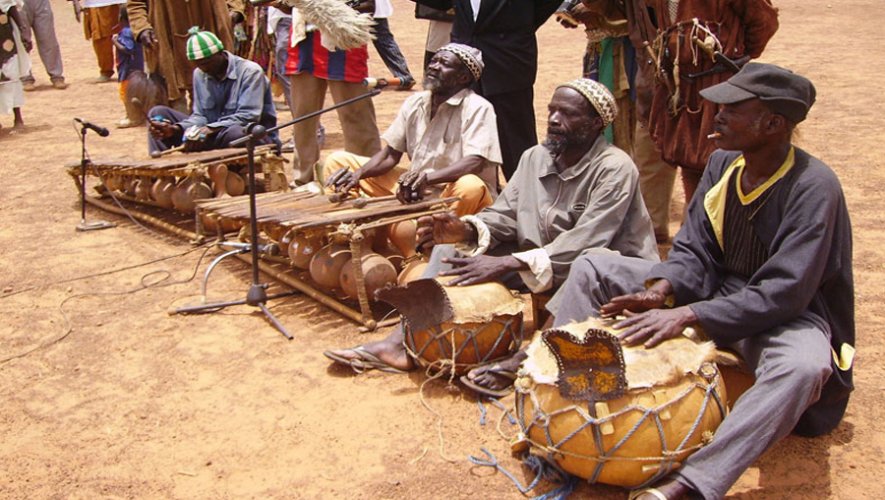
“The great balafonists are dead. Modernity has killed the very essence of the balafon, which used to thrill us during festivities, prayers, at work and at funerals. It is with nostalgia that Valy Coulibaly evokes the balafon of his early childhood. Where great names and valiant warriors and farmers were celebrated in the fields and in the moonlight. The balafon animates festivals, accompanies prayers in parishes and sacred woods, stimulates the ardour for work, punctuates funeral music and supports the teaching of value systems, traditions, beliefs, customary law, and ethical rules governing society and the individual in daily acts. “All this is coming to an end,” he laments. As if to relive the good old days, every Sunday afternoon in front of his home in Abobo Avocatier, he brings out his balafon made in Korhogo. In his own way, he tries to play the great songs of Zélé de Papara, known through his songs of love, reconciliation and peace, accompanied by his drum hanging from his hips, his head covered with a shepherd’s hat and a ponytail hanging from the handle of one hand, all mixed with his percussive voice and the sound of the balafon. Traoré Zélé, his real name, has managed to get noticed throughout Côte d’Ivoire and beyond the borders of Côte d’Ivoire, especially in the Senufo communities. The balafon is a xylophone made up of a wooden or bamboo support, on which are placed calabashes (resonance boxes) topped by wooden slats of increasing size. The balafon consists of a light wooden structure tied with leather straps, on which hardwood slats (oak) are arranged in increasing size and height (the shorter the slats, the higher the sound); pairs of small calabashes are placed underneath forming resonance boxes. Sometimes these gourds are pierced and the holes are covered with membranes that vibrate (the mirliton system). Traditionally these membranes were made of spider webs or bat wings, but today they are replaced by cigarette paper or a thin plastic membrane. The calabashes are getting bigger on one side, so the balafon is higher on one side than on the other. There is also a pair of wooden sticks with a rubber tip. The number of bars on the balafon varies depending on the region where it is played, and the tuning you want to give it. It is usually tuned in pentatonic (a scale of 5 notes) but can be tuned in diatonic (a scale of 7 notes) as well. The wooden slats of the diatonic balafon are thicker but not as wide as the pentatonic balafon, as the note must be higher. It is played either standing with straps supporting the balafon, or sitting. An orchestra often consists of three balafons, one low, one medium and one high, accompanied by vertical drums (djembe) and an armpit drum (tama).
The dangers of modernity
The complexity of the instrument requires many years of learning, almost all of which is done within the families of griots. It was through the first performances of Fodéba Keita’s African ballets and the national instrumental ensembles of Guinea and Mali that the West discovered the Malinke balafon in the 1960s. But it was not until the development of African music in the late 1980s that its use in the West began to grow. Less popular in France than the djembe or even the kora, the balafon has, however, entered many orchestras. Musicians bring together djembes, kora, ngoni and balafons, and by mixing them with electric guitars and synthesizers, create a new style strongly borrowed from traditional sources, but whose orchestration makes it a resolutely modern music. Popularised by numerous records, this phenomenon has allowed the Mandingo culture to spread outside Africa. The great balafon players have well-known names: El Hadj Djeli Sory Kouyaté, Mory Kanté, Adama Condé, Gert Kilian the white balafonist, Seydou Diabaté known as “Kanazoé”, Amadou Kienou, Lansiné Diabaté, Neba Solo. Traditionally, the Malinke balafon is tuned to seven equally spaced notes. Today, however, more and more balafonists living outside Africa tune their instruments to the Western scale, so that they can play with other instruments in orchestras. But many balafonists have changed the tuning of their balafon to fit the Western scales. Is there a risk that this phenomenon will become so widespread that traditional scales will be lost? This is a long-term risk, because we also see this phenomenon in Africa, when balafons are mixed with modern instruments like guitars and keyboards. One can also imagine various adaptations of the instrument such as the multiplication of the blades to add sharps or flats to instruments tuned in the West, the use of other essences or even other materials for the manufacture. Since December 2012, the balafon of the Senufo people has been listed as a UNESCO World Heritage Site. This is the result of a joint initiative by Côte d’Ivoire, Mali and Burkina Faso. “We must now promote this instrument, through activities that will be organized each year,” said the Minister of Culture and Francophonie, Maurice Kouakou Bandama. According to him, the balafon is an instrument that “plays a special important role”. “It serves to strengthen the bonds of solidarity, and therefore to celebrate peace and love. This instrument is recognised as having a universal value, which is to be preserved and promoted”, explained Minister Bandaman. In addition, he promised promotional actions so that “the balafonist from Boundiali or Korhogo can live from his art”.






0 Comments